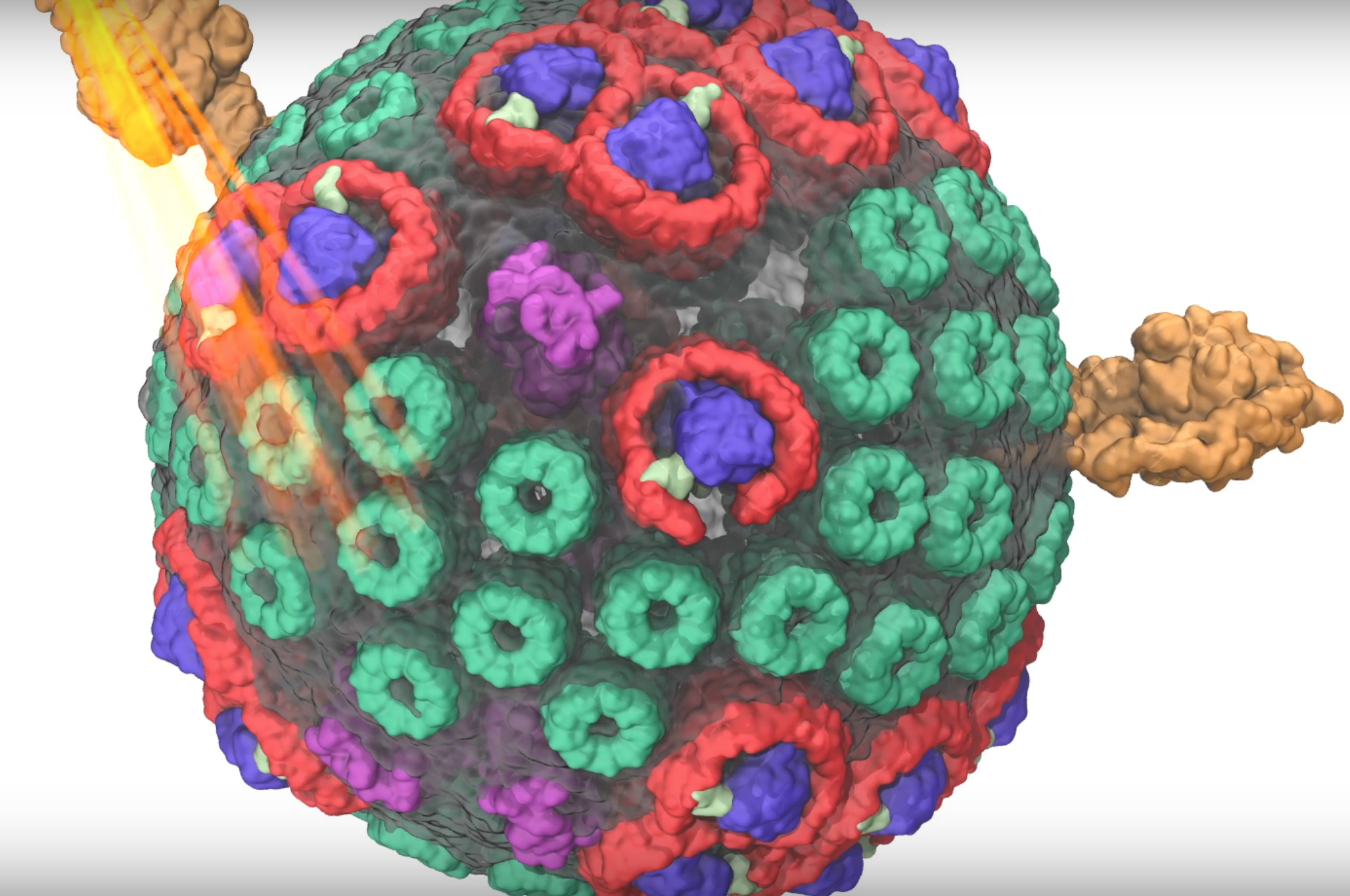An energy crisis can trigger years of fuel shortages and high gas prices. Energy shortages in biological cells are even more serious. Consequences include amyotrophic lateral sclerosis and aging-related disorders such as Alzheimer’s and Parkinson’s diseases.
Living cells in plants employ so-called bioenergetics machinery – an array of interlinked chemical reactions that convert sunlight to energy. Higher organisms do the same with nutrients. When the cells grow old they lose energy.
“Aging is a direct manifestation of energy leakage, and that energy leakage often happens through the formation of reactive oxygen species,” says Abhishek Singharoy, an assistant professor in molecular sciences at Arizona State University.
Singharoy studies two related bio-energetic processes with diverse potential applications in green energy and biomedicine. His work is supported with 200 million processor hours on the Titan supercomputer at the Oak Ridge Leadership Computing Facility (OLCF), a Department of Energy (DOE) Office of Science user facility. The allocation is part of DOE’s INCITE program (Innovative and Novel Computational Impact on Theory and Experiment).
Singharoy and his colleagues have focused on the purple bacterium Rhodobacter sphaeroides, a prototype system that can inform design principles for photosynthesis or energy conversion in higher organisms’ cellular respiration. It’s also an ideal model for computational and experimental companion studies.
“Proteins are not normally trained to sustain energy,” Singharoy says, but those of the purple bacterium are an exception. By “trained,” he means its proteins have evolved to cooperate to retain some of the solar energy they collect, converting it into adenosine triphosphate (ATP), an energy-storage molecule vital to all living organisms.
Proteins absorb sunlight differently – more efficiently – on a curved membrane than on a flat one.
“These bio-energy proteins are very hot molecular targets” in drug design, Singharoy says. Malarial parasites, for example, share a protein with purple bacteria. A drug called atovoquone can prevent malaria by choking off that protein’s activity during mitochondrial respiration – the chemical steps in cells that make ATP from nutrients.
Singharoy also hopes to draw on nature to design devices that harvest solar energy. Researchers typically don’t observe proteins’ energy-sustaining capability at the single-molecule level. Nonetheless, Singharoy discovered a hard-wired proficiency in proteins to store and transform energy in the cellular membrane. He has learned from his simulations, for example, that proteins absorb sunlight differently – more efficiently – on a curved membrane than on a flat one. “What is the underlying mechanism of the curvature of the membrane? It’s training the proteins to absorb sunlight in a certain way. That was very surprising.”
Surprises are becoming commonplace, now that Singharoy and his associates are preparing to publish results from the first simulation of a purple bacterium’s entire chromatophore – its 100-million-atom subcellular photosynthesis apparatus.
The emergence of petascale computers (capable of 1015 calculations per second) earlier this decade has enabled such previously unattainable simulations, which process and analyze data massive enough to fill millions of compact disks. They’re revealing how hundreds of proteins integrate their functions across an entire network and how they convert light into ATP and other energy forms. Singharoy and his colleagues now better understand how the purple bacterium’s chromatophore turns light energy into electrical energy, then into mechanical energy and finally into chemical energy.
The researchers have reported key findings in this multi-step process over the past two years, starting with an August 2016 overview in the journal Elife with lead author Melih Sener of the University of Illinois at Urbana-Champaign (UIUC). They described the system’s electrical and mechanical properties in two 2016 papers in the Journal of the American Chemical Society. Some of the biological ideas, reported in the Proceedings of the National Academy of Sciences in 2018 with Indiana University’s Amar Flood, are the basis for artificial molecular motors. These are biologically inspired devices that convert chemical energy into mechanical work to perform simple linear or rotatory motions on nanoscale tracks.
Singharoy, who joined the ASU faculty last January, has developed a far-flung network of collaborators to advance his research. They include Sener, ASU’s Petra Fromme, and Neil Hunter of England’s University of Sheffield, who leads investigations to validate computational predictions. Sener and Hunter are members of the DOE-supported Photosynthetic Antenna Research Center at Washington University in St. Louis, where the experiments are conducted.
At ASU, Singharoy is affiliated with the National Science Foundation’s Bio-XFEL Science and Technology Center, where researchers use X-ray free-electron lasers to observe biological machines at work. “Some of the experimental data that comes from that center goes directly into my modeling,” he says. An array of experimental methods generates this information, including electron microscopy (another thrust of his research), X-ray crystallography and mass spectrometry.
Singharoy also is active with the UIUC-based Center for Macromolecular Modeling and Bioinformatics, supported by the National Institutes of Health. The center is headquarters for UIUC’s Theoretical and Biophysics Group, established by the late Klaus Schulten, a founding father of molecular dynamics (MD) simulations. MD applies Newton’s laws of motion to atoms and molecules. Singharoy joined Schulten’s research group as a Beckman Fellow in 2013.
Schulten was fascinated by some proteins’ ability to store and transform energy, Singharoy says, something most of them aren’t designed to do. Photosynthetic and respiratory protein networks have this capability, though only for milliseconds –long enough for the proteins to change energy from one form into another. Singharoy has continued to follow Schulten’s path since the latter’s death in 2016.
Schulten led development of two key tools researchers have adopted worldwide: NAMD (nanoscale molecular dynamics) and VMD (visual molecular dynamics). Through sustained development of these tools, now led by UIUC’s Emad Tajkhorshid, Singharoy and colleagues have leveraged Titan’s parallel processing capabilities. Its graphic processing units (GPUs) have been critical to the success of both packages.
In fact, Singharoy credits the complementary visions of Schulten, for software development, and Jack Wells, OLCF director of science, for Titan’s hardware development as “the reason our major successes have come from supercomputing.”
